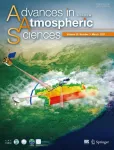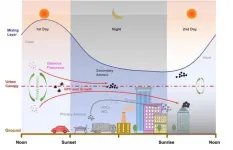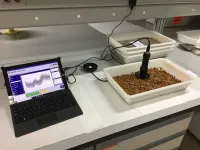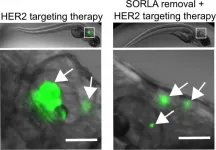Biobased anti-thrombosis agent
Potent trivalent inhibitors of thrombin from anticoagulation peptides in insect saliva
2021-01-29
(Press-News.org) Thrombosis, the clogging of blood vessels, is a major cause of heart attacks and embolism. Scientists have now engineered the first inhibitors of thrombin, a protease promoting thrombosis, that is three-fold efficient. In a study published in the journal Angewandte Chemie, the authors demonstrate that attacking three sites of the thrombin molecule is more efficient than attacking only two sites, which is the mode of action of many natural agents.
Soon after an injury, thrombin appears at the site of the wound, promoting platelet coagulation and fibrin development to clog the wound and grow new tissue. Unfortunately, inside blood vessels uncontrolled thrombin activity may lead to clogged pathways causing fatal outcomes for patients. Thrombosis has come into focus recently when it appeared that it was one of the major complications of severe COVID-19.
Many biting and blood-sucking insects carry natural anti-thrombosis factors to keep the blood in a wound liquid. Some of these natural inhibitors have been turned into medicine. The most applied thrombin inhibitor is hirudin, a peptide isolated from leeches.
In their quest to optimize thrombin inhibition, Richard J. Payne from the University of Sydney, Australia, in collaboration with an international team of scientists, scrutinized the way the inhibitors act. Most thrombin inhibitors from insects block two sites on thrombin. Usually, they attack the active site (the substrate-cleaving site) plus one of two other regions on the surface of the enzyme, which are important for regulating coagulation.
To cover all three sites with one drug, the researchers chose three natural inhibitors, which were then patched together. They connected the tsetse thrombin inhibitor, or TTI, from the tsetse fly with either an inhibitor peptide called variegin from a tropical tick or the inhibitor anophelin from the malaria mosquito Anopheles. The resulting hybrid peptides were designed to span all three binding sites of thrombin.
This design proved to be efficient. According to the authors, the "constructs from both hybrid series exhibited exquisitely potent thrombin inhibitory activities." The scientists reported up to 385-fold inhibition for the hybrid involving the peptides from tsetse fly and Anopheles mosquito. For the other hybrids, the improvements were still 2- to 10-fold. Notably, in human plasma all hybrids inhibited thrombin generation and platelet aggregation.
To test the constructs in a live body, the researchers applied one of the hybrids to a mouse model. Here, it made a thrombus shrink at least with the same efficiency as hirudin, and it reduced fibrin accumulation. The authors hope that this work will not only lead to efficient anticoagulation drugs, but will also help in the design of other peptide-based agents.
INFORMATION:
About the Author
Richard J. Paine is an Australian Research Council Future Fellow and Professor of Organic Chemistry and Chemical Biology at the University of Sydney. The Payne group applies the tools of organic chemistry to develop new drug leads and therapeutic candidates using a multidisciplinary approach.
https://www.sydney.edu.au/science/chemistry/~payne/
ELSE PRESS RELEASES FROM THIS DATE:
2021-01-29
An international team of scientists, coordinated by the Seville Institute of Biomedicine (IBiS) and the University of Seville has solved one of the hitherto unresolved enigmas of basic biology: how exactly do lipids distribute proteins within a cell? To do this, they used a new, completely innovative microscopy technology, which they applied to "mutant" cells they designed in their laboratory.
This discovery represents a major advance in understanding how proteins are distributed in cells to perform their vital functions, and could open the door to understanding the causes of diseases associated with failures in protein distribution at the ...
2021-01-29
Researchers have completed the first ever multi-level hydrological tracking of the Yangtze River from the ground, air and space in order to investigate the properties of cloud formation during the mei-yu--an intense rainy season that forms part of East Asia's summer monsoon. The effort should permit greater understanding of the mei-yu precipitation process and thus enable much more accurate forecasts of this key meteorological phenomenon in the region.
The mei-yu, also known as the "Plum Rain", is a period of severe, concentrated rainfall that lasts for up to two months during the late ...
2021-01-29
Knowledge about health is a cornerstone in a child's development of physical and psychosocial health.
Since 2016, around 25,000 pupils in years 4-6 in 86 of Denmark's municipalities have taken part in the project "11 for Health in Denmark", an 11-week exercise and health education programme offered to all schools in a collaboration between the University of Southern Denmark and the Danish Football Association.
More than 3,000 of these pupils completed questionnaires before and after the programme aimed at determining their knowledge about health and understanding their experience of the 11-week programme.
An increase of 10 percentage ...
2021-01-29
New particle formation (NPF) is a major source of aerosol particles in the global atmosphere. In polluted megacities, such as Beijing, the role of new particle formation events and their contribution to haze formation through subsequent growth is still unclear.
To improve the understanding of the sources, meteorological conditions, and chemistry behind air pollution, the research teams led by Prof. Yele Sun with the Institute of Atmospheric Physics at the Chinese Academy of Sciences and Prof. Markku Kulmala with the University of Helsinki performed simultaneous measurements ...
2021-01-29
Research on manufacturing battery cells is gaining momentum - and there is a strong need, considering the future demand for energy storage: For the year 2030, global production of rechargeable batteries will double from today's 750 gigawatt hours (GWh) per year to 1,500 GWh. A recently published review article in the magazine "Nature Energy" on cell production of various battery types suggests that the currently established lithium-ion batteries (LIB) dominate the market of rechargeable high-energy batteries in the coming years. Alternative battery technologies, ...
2021-01-29
Large parts of today's Sahara Desert were green thousands of years ago. Prehistoric engravings of giraffes and crocodiles testify to this, as does a stone-age cave painting in the desert that even shows swimming humans. However, these illustrations only provide a rough picture of the living conditions. Recently, more detailed insights have been gained from sediment cores extracted from the Mediterranean Sea off the coast of Libya. An international research team examined these cores and discovered that the layers of the seafloor tell the story of major environmental changes in North Africa over ...
2021-01-29
The biological process of photosynthesis is found at the beginning of nearly all food chains. It produces oxygen to breathe and provides the energetic foundation for using biotechnological processes to synthesize biofuels and chemical feedstock. Therefore, researchers are particularly interested in rapidly growing cyanobacteria. These organisms use light as an energy source and can carry out photosynthesis, similar to plants. However, the required photosynthetic protein complexes bind many nutrients. Vanessa Krauspe and Prof. Dr. Wolfgang Hess from the working group for Genetics & Experimental Bioinformatics of the Faculty of Biology of ...
2021-01-29
Who hasn't at some point been chewing on an almond and tasted an unpleasant and unexpected aftertaste that has nothing to do with the taste we are used to from one of the most consumed nuts in the world? The culprit has a name: amygdalin, a diglucoside that, when in contact with enzymes present in saliva, breaks down into glucose, benzaldehyde (the cause of the bitter taste) and hydrogen cyanide.
To reduce this unpleasant 'surprise', the Farming Systems Engineering (AGR-128) and Food Technology (AGR-193) research groups at the University of Cordoba's School of Agricultural and Forestry Engineering, ...
2021-01-29
SORLA is a protein trafficking receptor that has been mainly studied in neurons, but it also plays a role in cancer cells. Professor Johanna Ivaska's research group at Turku Bioscience observed that SORLA functionally contributes to the most reported therapy-resistant mechanism by which the cell-surface receptor HER3 counteracts HER2 targeting therapy in HER2-positive cancers. Removing SORLA from cancer cells sensitized anti-HER2 resistant breast cancer brain metastasis to targeted therapy.
HER2 protein is a strong driver of tumor growth. HER2 amplification occurs ...
2021-01-29
High-intensity tropical cyclones have been moving closer to coasts over the past 40 years, potentially causing more destruction than before.
The trend of tropical cyclones - commonly known as hurricanes or typhoons - increasingly moving towards coasts over the past 40 years appears to be driven by a westward shift in their tracks, say the study's authors from Imperial College London.
While the underlying mechanisms are not clear, the team say it could be connected to changes in tropical atmospheric patterns possibly caused by climate change. The research is published today in Science.
Globally, 80 to 100 cyclones develop over tropical oceans each year, impacting regions in the Pacific, ...
LAST 30 PRESS RELEASES:
[Press-News.org] Biobased anti-thrombosis agent
Potent trivalent inhibitors of thrombin from anticoagulation peptides in insect saliva







